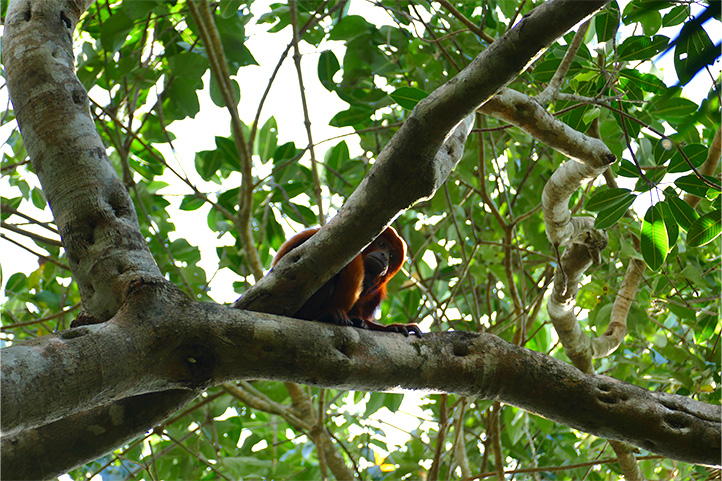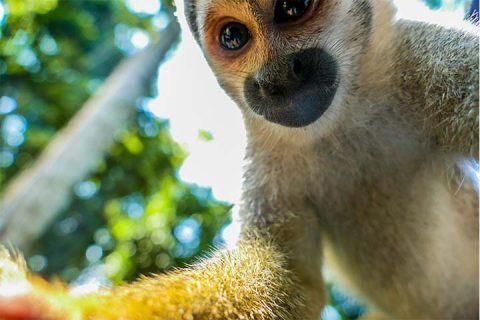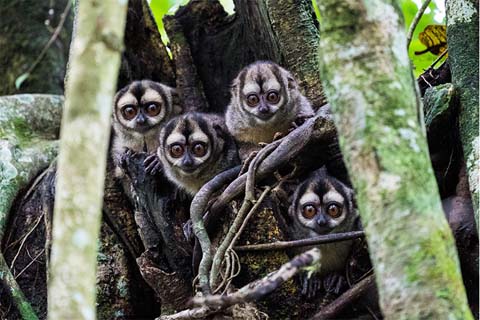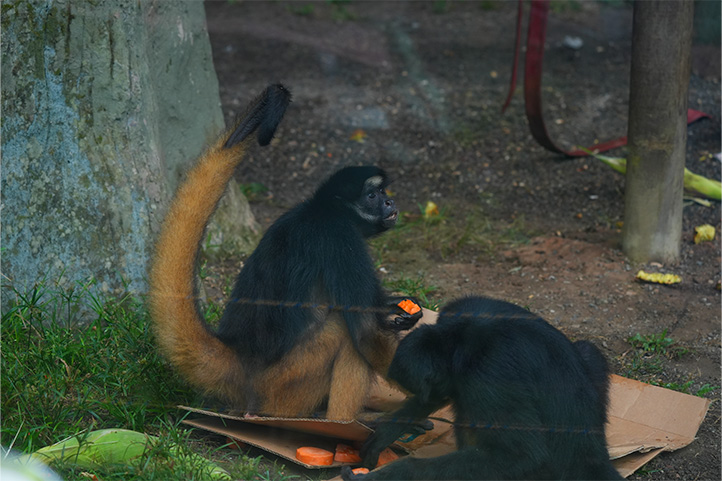Updated on 04/22/2024
Dear reader,
I would also like to recommend our Colombia travel guide, which provides a perfect overview of the tourist attractions in Colombia. Enjoy reading it!
In the lush Colombian jungle, monkeys are one of the most fascinating species in the ecosystem. With a huge variety of primates, Colombia is an excellent place to meet these species and learn more about them. So, join us as we explore the 9 must-see destinations for monkey watching.
Content
ToggleWhere to watch monkeys in Colombia
Here are some of the best places to observe monkeys in Colombia:
Tayrona National Natural Park, Santa Marta
Location: Santa Marta via Riohacha.
Price: Admission fee required. Check current rates.
Website: Tayrona National Park
Tayrona National Natural Park is a natural reserve that is part of the sacred territory of four indigenous communities (Arhuaco, Kogui, Wiwa, and Kankwamo). Therefore, this area is fundamental to the worldview and spirituality of indigenous groups.
It covers an area of 15,000 hectares where various types of forests exist, such as dry, humid, and cloudy forests. Additionally, you can observe beach ecosystems, lagoons, mangroves, and rocky coastlines. Moreover, the marine area features coral formations and algae meadows.
Numerous species of flying mammals, large and medium-sized mammals, and birds are recorded here. For example, bats, howler monkeys, iguanas, and pelicans, respectively.
In this park, monkey species stand out because they are found throughout the natural environment, including:
- Capuchin monkeys
- Howler monkeys
- Maicero monkeys
- White-faced capuchin monkeys
Services and activities
In addition, the following ecotourism activities take place in the park:
- Birdwatching
- Fauna and flora observation
- Snorkeling
- Diving
- Land hiking with over 30 km (18 miles) focused on ecological hiking.
- Lodging service.
How to get there: Upon arriving in Santa Marta, take the Caribbean Highway Santa Marta – Riohacha, and after approximately 45 minutes, you will see signs indicating the entrances to Tayrona National Park (PNN Tayrona). The main entrance, El Zaino, and the park ticket office are located 30 km (18 miles) from the metropolitan area of Santa Marta. It’s about a 40-minute drive or bus ride.
Gorgona Island National Natural Park, Guapi
Location: The island is in the Pacific Ocean.
Price: Admission fee required. Check current rates.
Website: Gorgona National Park
Gorgona Island National Natural Park is a natural reserve located on Gorgona Island, famous for its lush and exuberant tropical rainforest. In the past, this area used to be a prison, but it was closed, and in 1983, it was converted into an area for the protection and care of resident fauna and flora. Although these animals are not exhibited as in the previous places mentioned, you can observe a wide variety of bird, amphibian, terrestrial mammal, and reptile species freely in their habitat.
Among these mammals, you can find primates such as:
- Capuchin monkeys
- White-faced capuchin monkeys
- Squirrel monkeys
During your tours of this island, you can observe these fascinating animals in their natural environment.
Services and activities
In addition to guided hiking tours to observe these species, this park offers:
- Boat rides
- Geological observations
- Fauna and flora observation
- Whale watching
- Birdwatching
- Non-commercial photography
- Snorkeling
- Lodging
- Restaurant services.
Amacayacu National Natural Park, Puerto Nariño
Location: Located in the Amazon Trapezoid.
Price: Admission fee required. Check current rates.
Website: Amacayacu National Park
This park is a natural reserve of wildlife and natural resources covering an area of 293,500 hectares. It represents about 40% of the total surface area of the Amazon Trapezoid, located between Puerto Nariño and Leticia. Additionally, the reserve shares territories with the Tikuna ethnic group.
This reserve covers a warm tropical rainforest ecosystem and floodable forests. The greatest diversity of primates on the planet lives in these forests. Likewise, there are over 5,000 species of plants, abundant birds, and mammals. It also has the largest number of reptiles in the country. In fact, the Amazon is conceived as a paradise for snakes.
And most importantly, you can encounter incredible mammals such as:
- Lion tamarin monkeys
- Colombian squirrel monkeys
- Spider monkeys
- Night monkeys
- Woolly monkeys
- Capuchin monkeys
- Tamarind monkeys
Similarly, you will find manatees, pink dolphins, alligators, silver-blue butterflies, and the largest lotus flower in the world.
Services and activities
- Species observation
- Restaurant service
- Canoeing
- Nocturnal hiking
- Bathing in rivers and streams
However, the main activity that includes the previous ones is visiting the indigenous community of San Martín de Amacayacu. You can go by boat, but you can also hike and observe all their species of fauna and flora during your journey.
How to get there: You must take a boat from Leticia to the park entrance, the journey takes 1 hour and 30 minutes.
Maikuchiga Primate Reserve, Leticia
Location: Located in Mocagua, Mocagua Indigenous Reserve, Leticia.
Price: Admission fee required.
Website: Maikuchiga Foundation
Did you know that in the Tikuna language, “Maikucha” means “monkey story”? And indeed, the Maikuchiga primate reserve, located 70 km (43 miles) from Leticia, exactly in Mocagua, is a beautiful tourist destination that rehabilitates primates and teaches visitors interesting aspects about these animals.
It offers visitors the opportunity to experience the beauty and biodiversity of the Amazon rainforest in a unique way because the species are in their natural environment. Therefore, you can observe them. Remember that this is a sanctuary, so the animals are not for display. I recommend not feeding them with unauthorized food or treating them like ornaments.
The island is home to various primates that have lost their mothers and families, including:
- Tamarins
- Capuchin monkeys
- Titi monkeys
- Flying monkeys
- Squirrel monkeys
- Spider monkeys
And other species that have suffered from poachers.
In addition, you can observe birds such as macaws, toucans, and parrots. Interestingly, in the past, the Mocagua people consumed or sold these primates. However, now, thanks to ecotourism, efforts are made to preserve and rehabilitate them.
Services and activities
- Hiking
- Fauna observation, such as primates and birds
- Awareness talks
- Volunteering
- Lodging
- Restaurant service.
This is definitely my favorite place to watch monkeys!
Getting there: To reach Maikuchiga, you must navigate for 45 minutes by boat from Leticia, first passing through the Amacayacu River, around 15 minutes until reaching the Amazon River. After navigating downstream, you will arrive at the Mocagua community.
Jaime Duque Park, Tocancipá
Location: km 34 Autopista Norte – Tocancipá, Cundinamarca
Price: Admission fee required. Check current rates.
Website: Jaime Duque Park
Jaime Duque Park is located in Tocancipá, near Bogotá, Colombia. It is a theme park named after the Colombian aviator Jaime Duque Grisales. This park offers a variety of attractions and activities for visitors, such as an amusement park, art exhibitions, guided tours, tours in an airplane museum, food services in over 4 restaurants, and of course, a natural reserve.
In its natural reserve, called Wakatá, numerous species such as spectacled bears, macaws, spider monkeys, and of course, other primates are found. For example:
- Lion-headed tamarins, a unique species in Colombia
- Squirrel monkeys
- Capuchin monkeys
Services and activities
- Guided tours by experts who will teach you many facts about the different animals you will see on the tour. Additionally, the animals live in habitats that emulate their ecosystems, and 60% have been referred to this reserve by environmental authorities. So, it’s a fascinating experience.
- After completing your tour, you can take professional photos as the park offers this service.
- Shops to buy souvenirs
- Restaurant service
- Mechanical attractions
Cali Zoo, Cali
Location: Cra. 2a Oe., Terrón Colorado, Cali, Valle del Cauca.
Price: Admission fee required. Check current rates.
Website: Cali Zoo
Cali Zoo is one of the most important and frequented zoos in Colombia. It focuses on species conservation, environmental education, and scientific research, housing a wide variety of animals, estimated to be over 2,500, including mammals, birds, reptiles, and fish. Among the species you can find are jaguars, hippos, and monkeys such as:
- Spider monkeys
- Squirrel monkeys
- White-faced capuchin monkeys
- Churucos monkeys
- Black-faced monkeys
- Howler monkeys, and more
Services and activities
- Guided tours
- Workshops
- Sports activities
- Myths and legends stories
- Educational programs and activities to raise awareness among visitors about the importance of biodiversity conservation
- Restaurant service
One aspect I love about this zoo is that with the help of professionals, they rehabilitate animals that have been victims of trafficking, abuse, or the killing of their herd, etc. And they often share these processes with their followers on, for example, their TikTok account. It’s truly a memorable place!
Ukumarí Biopark, Pereira
Location: Km 14 via cerritos, entrance by Santa Bárbara gas station, Pereira.
Price: Admission fee required. Check current rates.
Website: Ukumarí Biopark
Ukumarí Biopark is a thematic park and zoo that focuses primarily on biodiversity conservation and environmental education. Therefore, it houses a variety of animal species, including mammals, birds, reptiles, and more. These are categorized and divided into the African, Noah’s Ark, and Andean Forests environments.
Regarding primates, they inhabit imitations of their natural ecosystems, among them, you will find the white-faced monkey and fascinating chimpanzees.
The park stands out for its efforts to provide the most natural environment possible for the animals, as well as for its educational programs aimed at raising awareness among visitors about the immense importance of conservation and respect for wildlife.
Services and activities
- Guided tours
- Adoption campaigns
- Restaurant service
- Fairs
- Environmental workshops
- Corporate events
Guátika Biopark, Tibasosa
Location: Km 1, Via las Antenas, Tibasosa, Boyacá.
Price: Admission fee required. Check current rates.
Website: Guátika Biopark
Guátika Biopark is a zoo with over 1,000 animals and 100 exotic, wild, and domestic species that for various reasons can no longer live in their natural habitats. Among its animals are tigers, lions, ostriches, and of course, capuchin monkeys.
Apart from guided tours through the area where the animals live, the park offers other services, such as:
- Buggy races
- Lodging
- Aerial swing
- Family and corporate tours
- Horseback riding on ecological trails
- Climbing wall
- Children’s attractions
- Zip line
- Feeding domestic animals
- Restaurant service
This park is perfect for family fun!
How to get there: It is suggested not to use Waze to arrive; the biopark is 3 hours from Bogotá and just 10 minutes from downtown Tibasosa by km 1.
Barranquilla Zoo, Barranquilla
Location: Cl. 77 #68 – 40, Nte. Historic Center, Barranquilla, Atlántico.
Price: Admission fee required. Check current rates.
Website: Barranquilla Zoo
Barranquilla Zoo is a space committed to biodiversity conservation and environmental education that houses a varied collection of over 600 animals, from mammals to birds, reptiles, and amphibians. Among its residents are lions, an elephant, tigers, monkeys, and more than 36 snakes, of which 33 are native. Regarding its primates, species such as:
- Titi monkeys
- Pygmy marmosets
- Woolly monkeys
- Baboons
Services and activities
In addition to its focus on wildlife exhibits, the zoo also offers the public:
- Educational programs aimed at raising public awareness about the importance of conservation and respect for nature.
- Workshops
- Talks
- Guided tours
- Restaurant service
Recommendations for observing monkeys in Colombia
Here are some suggestions that will help you avoid setbacks when observing monkeys.
- Seek sanctuaries or natural reserves to meet monkey species: The places I mentioned are all natural reserves dedicated to caring for these animals. In certain Colombian cities, it’s common for people to illegally capture these animals for photos or sales, constituting serious wildlife trafficking. This not only jeopardizes your safety but also harms the species’ welfare. If you’re going to the Amazon, avoid the infamous “monkey island” in Iquitos.
- Don’t touch or take flash photos of monkeys: in most reserves, it’s strictly forbidden to approach the animals. You shouldn’t approach their enclosures or throw objects at them, nor should you take flash photos of them as this could disturb them.
- Bring cash: in most of the mentioned places, cards or online payments are accepted, but sometimes due to distances or weather conditions, they may not work. So, be prepared with local cash.
- Wear comfortable and lightweight clothing: Whether you’re observing them in an enclosed area or in the wild, expect to do some walking. Opt for comfortable and lightweight workout clothes, and don’t forget a cap and sneakers for practicality.
Fun facts about monkeys
Here are some interesting facts that will further encourage you to get to know these fascinating primates.
- The term “monkeys” often refers to specific types of primates, particularly those smaller in size and resembling the stereotypical image of a monkey, like tamarins or capuchins. However, scientifically, primates are not classified as “monkeys.”
- From colorful tamarins to imposing howler monkeys, these primates have adapted their lives to a wide range of habitats, from the treetops in tropical rainforests to mountainous areas.
- Some species, like the lion-headed tamarin endemic to Colombia, add a unique touch to the global diversity of primates.
- In Colombia, there are various opportunities for those passionate about primatology or curious individuals who want to learn more about these amazing jungle or forest inhabitants. However, it’s essential to approach their observation with respect and consideration, due to several reasons such as:
- These animals can be sensitive to human presence.
- And currently, many are victims of poachers, wildlife trafficking, or have been displaced by people who have destroyed their ecosystems.
Primate Species You Can Find in Colombia
Lion tamarin (Leontopithecus rosalia)
- Characteristics: small primate with golden and white fur endemic to Colombia.
- Habitat: tropical rainforests.
Red howler monkey (Alouatta seniculus)
- Characteristics: large monkey with reddish fur and powerful roar.
- Habitat: forests and woods.

Pygmy marmoset (Cebuella pygmaea)
- Characteristics: small primate with long tail and colorful fur.
- Habitat: tropical forests.
Brown spider monkey (Ateles hybridus)
- Characteristics: spider monkey with brown fur and long limbs.
- Habitat: rainforests and humid forests.
Capuchin monkey (Cebinae)
- Characteristics: medium-sized primate with a hood of hair on its head.
- Habitat: forests and wooded areas.
Titi monkey (Callicebinae)
- Characteristics: small titi monkey with black and white fur, long tail, and soft fur.
- Habitat: tropical forests and riparian areas.
Woolly monkey (Lagothrix)
- Characteristics: medium-sized primate with long, woolly fur, ranging from brown to black.
- Habitat: humid forests and lowland forests.
White-headed titi (Saguinus oedipus)
- Characteristics: small titi with gray and white fur, distinctive for its white facial mask.
- Habitat: tropical forests and transition zones.
Common squirrel monkey (Saimiri sciureus)
- Characteristics: small primate with dense fur and long tail, varied colors in shades of gray and yellow.
- Habitat: jungles and secondary forests.

Night monkey (Aotus)
- Characteristics: nocturnal primate with large eyes, soft fur, and variation in shades of gray and brown.
- Habitat: forests and wooded areas.

Brown-headed pygmy marmoset (Cebuella pygmaea)
- Characteristics: pygmy marmoset with brown fur, long tail, and distinctive snout.
- Habitat: lowland forests and mountains.
More Nature Tourism Experiences in Colombia
Here is a list of incredible destinations for hiking and other nature activities in Colombia:
- The Best Hiking Routes in Colombia.
- The Most Representative Flowers in Colombia.
- Cacao Guide in Colombia.

